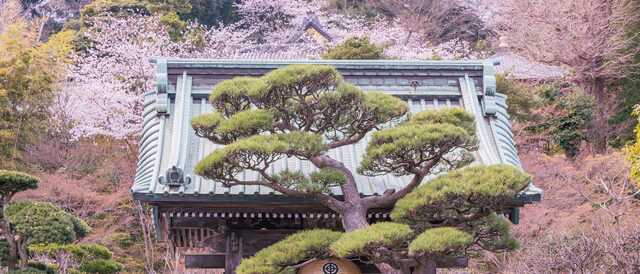Sakura at Hase-dera
The Charm of Hasedera Temple Sakura
Hasedera Temple in Kamakura is one of the most beautiful places to enjoy cherry blossoms in spring. Particularly, from mid-February, Kawazu-zakura begins to bloom, painting the temple grounds in soft spring colors. In front of the Kannon Hall and around Myochi Pond, the deep pink Kawazu-zakura blossoms flourish, offering an early taste of spring. Around the same time, Kanhi-zakura in front of the Amida Hall also reaches its peak, delighting visitors with its vibrant hues.
Best Viewing Time and Recommended Spots
By late March, the entire temple grounds are enveloped in Somei Yoshino and Shidare-zakura cherry blossoms, turning it into a true sakura paradise. Some of the best spots to enjoy the blossoms include:
- In front of the Kannon Museum
- Near the Main Gate
- Beside Benten Cave
- Around Myochi Pond
Among them, the view of Kannon Hall and the cherry blossoms is breathtakingly beautiful, captivating many visitors. From the stage of the main hall, you can take in the entire cherry blossom scenery within the temple grounds, offering a truly spectacular view. Additionally, the reflection of the cherry blossoms in Myochi Pond creates a stunning contrast with the water’s surface, making it a perfect spot for photography.
Hana Matsuri and Spring Events
On April 8, Hasedera Temple hosts “Hana Matsuri”, celebrating the birth of Buddha. The Sakura Plaza beside the Kannon Hall is beautifully adorned for this occasion. Visitors can participate in the ritual of pouring sweet tea (Ama-cha) over a Buddha statue, and sweet tea is also offered to guests. Traditional performances of koto and shakuhachi add to the solemn yet festive atmosphere.
Best Times to Avoid Crowds
During the cherry blossom season, the temple attracts many visitors. For a more peaceful experience, it is recommended to visit on weekdays or right after the temple opens at 8:00 AM. The time before closing is also relatively quiet, but ensuring enough time for viewing is essential.
Enjoying the Scenery After the Cherry Blossoms
From mid-April onward, as the cherry blossoms begin to fall, azaleas start to bloom. Visitors can enjoy the transition from spring to early summer as they stroll through the beautiful temple grounds at a leisurely pace.
Please note that there are no nighttime illuminations during the cherry blossom season, so plan accordingly when visiting.
Conclusion
The cherry blossoms at Hasedera Temple can be enjoyed over an extended period, from February’s Kawazu-zakura to April’s Somei Yoshino. Especially around Myochi Pond and Kannon Hall, visitors can immerse themselves in the stunning scenery of spring. If you are visiting Kamakura, don’t miss the chance to experience Hasedera Temple’s breathtaking cherry blossoms.
Toshi’s Evaluation
| Evaluation Criteria | Score | Reason |
|---|---|---|
| Scenic Beauty | 10 | The cherry blossoms, especially the weeping cherry and Somei Yoshino varieties, beautifully harmonize with the historic architecture and Myochi Pond, creating a highly photogenic setting. |
| Accessibility | 9 | Located just a 5-minute walk from Hase Station on the Enoden Line, it is very convenient with clear signage. However, parking is available but paid, which slightly lowers the score. |
| Historical Value | 9 | Known as the “Temple of Flowers,” it holds significant historical and cultural value with its statues and gardens deeply tied to Kamakura’s heritage. |
| Comfort | 8 | Facilities like restrooms and seating areas are well-maintained, but the comfort level can decrease slightly due to crowding during cherry blossom season. |
| Reviews | 9 | Highly rated by both domestic and international visitors, with many photos shared on social media. However, some reviews mention concerns about overcrowding. |
Total Score: 45 Points
Hase-dera Temple offers a stunning blend of cherry blossoms and historical architecture, making it one of Kamakura’s most attractive spots for viewing sakura. While crowding during peak season may slightly impact comfort, its scenic beauty and cultural significance more than make up for it.


